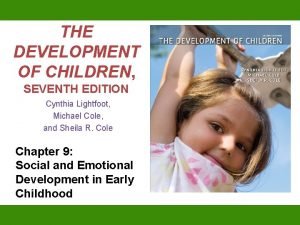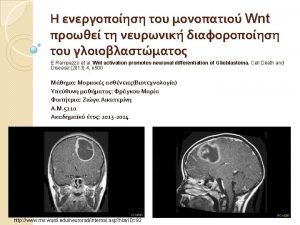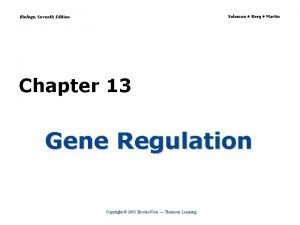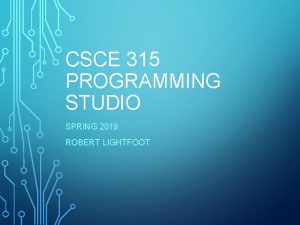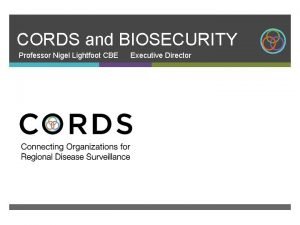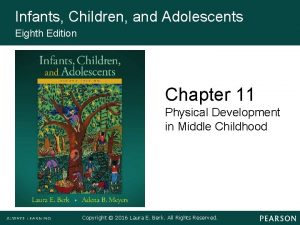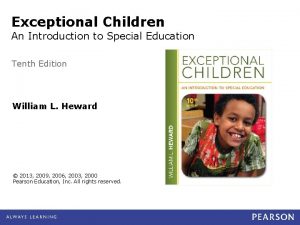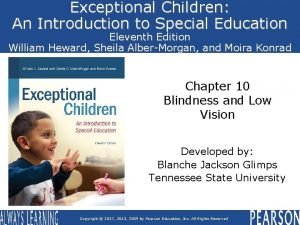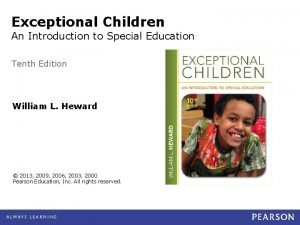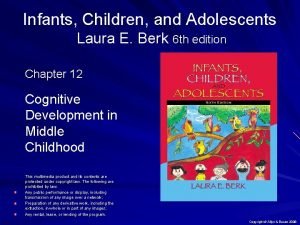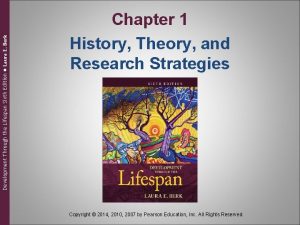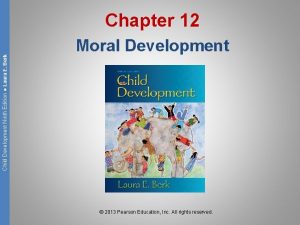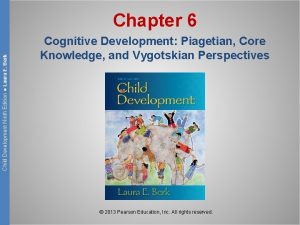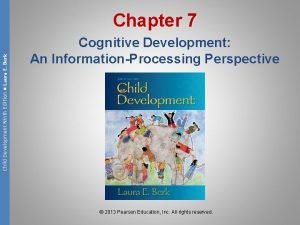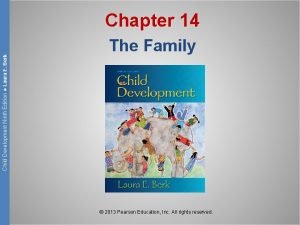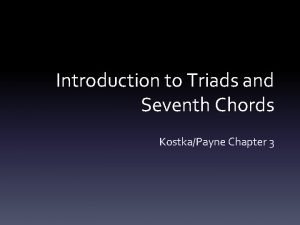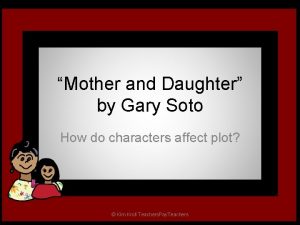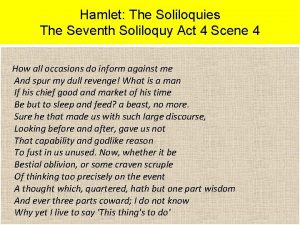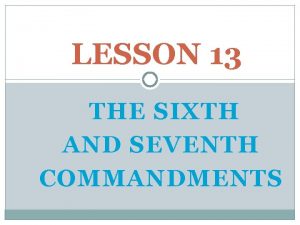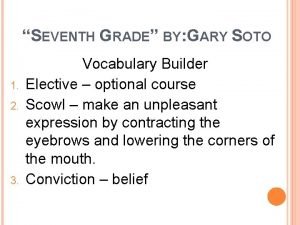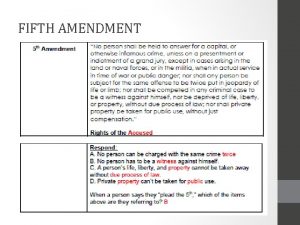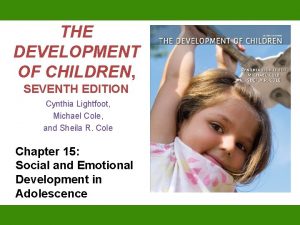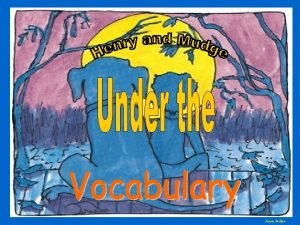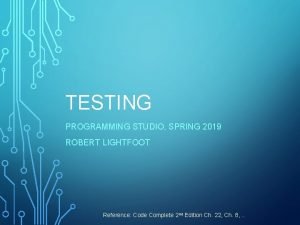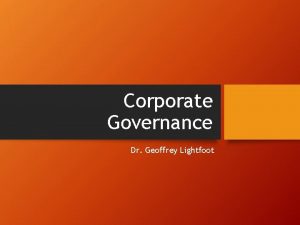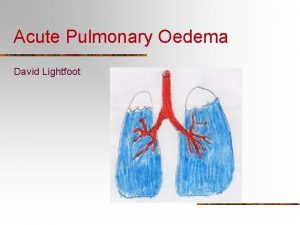THE DEVELOPMENT OF CHILDREN SEVENTH EDITION Cynthia Lightfoot



















































- Slides: 51

THE DEVELOPMENT OF CHILDREN, SEVENTH EDITION Cynthia Lightfoot, Michael Cole, and Sheila R. Cole Chapter 11: Physical and Cognitive Development in Middle Childhood

Chapter Overview I. Physical and Motor Development II. Concrete-Operational Development III. Information-Processing Approaches IV. The Role of Social and Cultural Contexts V. Individual Differences in Cognitive Development VI. Reconsidering the Cognitive Changes in Middle Childhood

Beginning of Middle Childhood • New expectations • Increases: – Physical capacities – Cognitive abilities • “social intelligence”

I. Physical and Motor Development • Increases – Size – Strength

Physical and Motor Development • Increases – Muscle mass – Fat tissue

Height and Weight • Influences – Genetic factors – Environmental factors • For example, childhood obesity

Six Cs Developmental Ecological Model • Kristen Harrison and her Colleagues – Cell – Child – Clan – Community – Country – Culture

Motor Development • • Strength Agility Balance Role of Practice

Gender Differences • Boys – Motor abilities requiring power or force – Greater muscle mass • Girls – Fine motor skills – Gross motor skills that combine balance and foot movement • Cultural Conceptions

Brain Development • Brain changes development underlying cognitive – Myelination – Synaptic pruning – Change in brain activity patterns – Increase in synchronization of electrical activity in different brain areas • EEG coherence

Brain Development

I. Apply – Connect – Discuss • Discuss some of the ways that physical activity affects physical and psychological development of girls and boys during middle childhood. • In your discussion, consider how the effects are similar for boys and girls, how they may differ, and the extent to which culture may contribute to any gender differences you identify.

II. Concrete-Operational Development • Piaget • Concrete Operations Coordinated mental actions that fit into a logical system in a way that creates greater unity of thinking.


Concrete Operations • Children’s behaviors become more – Organized – Flexible – Predictable

Concrete Operational Thinking • Change in abilities – Conservation – Classification – Planning – Metacognition

Conservation • Conservation Piaget’s term for the understanding that some properties of an object or substance remain the same even when its appearance is altered in some way.

Conservation • Conservation of number Recognizing the one -to-one correspondence between sets of objects of equal number.

Conservation • Conservation of volume Understanding that the amount of liquid in a container remains the same despite being poured into a differently shaped container.

Classification • Relationship between a superordinate class and its subclasses – Relation of inclusion • Categorizing objects according to multiple criteria

Planning • Forming mental representations of actions needed to achieve a goal

Metacognition • Metacognition The ability to think one’s own thought processes.

Concrete Operations • Limitations – Abstract reasoning

II. Apply – Connect – Discuss • Explain how Piaget’s fundamental concepts of decentration and objectivity are apparent in the ability of children who are at the concrete-operational stage to solve conservation and classification tasks.

III. Information-Processing Approaches • Reasons for cognitive changes – Increased memory capacity – Increased attention – Rapid and efficient mental operations – Acquisition of new mental strategies

The Role of Memory • Three factors bring about characteristic memory changes: 1. Increased speed and capacity of working memory 2. Expanded knowledge base 3. Improved memory strategies

Working Memory • Capacity Increases – Memory span • Speed Increases – Time to repeat a series decreases – Results in increase in memory capacity

Memory strategies • Rehearsal • Organizational strategies • Elaboration

Thinking about Memory • Metamemory The ability to think about one’s memory processes. – A form of metacognition • Examples – Awareness of memory limitations – Connection with use of memory strategies

Increased Control of Attention • Regulating attention – Staying focused – Ignoring distractions

Executive Function • Aspects of cognition associated with supervising and controlling lower-level cognitive processes. (similar to selfreguation)

III. Apply – Connect – Discuss • Many people believe that a really good memory involves the ability to store a lot of information for considerable periods of time. • Good memory, however, is not just about the quantity of information stored overtime, but also about how the information is organized.

Apply – Connect – Discuss • In what specific ways does it seem that children’s memories may be organized differently in middle childhood than in early childhood?

IV. The Role of Social and Cultural Contexts • Cultural Variations in: – Acquisition of Conservation – Use of Memory Strategies – Planning

The Universality of Conservation • Traditional, nonindustrial cultures – Lag behind industrialized countries – Require training – Fewer differences using native language


Memory Strategies • Effects of schooling – Use of organizational strategies • Clustering – Unschooled children performed well when objects presentation was meaningful, as opposed to random

Planning • Cultural Values – Navajo versus European American • Careful planning vs. speed

IV. Apply – Connect – Discuss • In what ways does Michael Cole’s study of Liberian children suggest that culture contributes both to children’s knowledge bases and to the type of memory strategies that children favor?

V. Individual Differences in Cognitive Development • Definitions of Intelligence – Anchored to cultural contexts – Is there a clear meaning? • Cultural Variations – Social competence – Cognitive competence

Measuring Intelligence • Alfred Binet and Théodore Simon – Cognitive Competence – “Mental age” • Intelligence Quotient (IQ score) – Comparing children of the same age

IQ Score • The ratio of mental age to chronological age – IQ = (MA/CA)/100 – average IQ normalized to 100

Persistent Questions about Intelligence 1. Is intelligence a general characteristic or are there specific kinds of intelligence? 2. Are differences among individuals and among groups in performance on IQ tests the result of genetic or environmental factors? 3. To what extent might IQ tests be culturally biased?

The Nature of Intelligence • General Intelligence • Multiple Intelligences – Howard Gardner • Sternberg’s. Triarchic Theory 1. Analytic 2. Creative 3. Practical


Population Differences • Innatist Hypothesis of Intelligence – Intelligence is innate, and immune to training • Environmental Hypothesis of Intelligence – Intelligence is specific and heavily dependent on experience

Environmental Hypothesis • Flynn Effect The steady increase over the past 100 years in IQ test performance.

IQ Tests as Culturally Biased • Culturally specific – IQ tests are rooted in schooled society – Cultures differ in modes of representation • No satisfactory “culture-free” intelligence test yet.

V. Apply – Connect – Discuss • IQ tests were first developed in order to identify children who needed special education. • Today, the use of IQ tests in making decisions to place children on different “academic ability tracks” is hotly debated.

Apply – Connect – Discuss • Using concepts and research evidence presented in this section, describe the pros and cons of IQ testing and ability tracking in schools.

VI. Reconsidering the Cognitive Changes in Middle Childhood • New powers of thought and action – More systematic – More broadly applied • More cross-cultural work is needed
 Cynthia lightfoot
Cynthia lightfoot Gordon lightfoot ethnicity
Gordon lightfoot ethnicity Endomysium
Endomysium Chords rule in dbms
Chords rule in dbms Principles of information systems, seventh edition
Principles of information systems, seventh edition Molecular biology of the cell seventh edition
Molecular biology of the cell seventh edition Biology seventh edition
Biology seventh edition Guy lightfoot
Guy lightfoot Guy lightfoot
Guy lightfoot Robert lightfoot tamu
Robert lightfoot tamu Joshua lightfoot
Joshua lightfoot Nigel lightfoot
Nigel lightfoot Infants and children 8th edition
Infants and children 8th edition Infants children and adolescents 8th edition
Infants children and adolescents 8th edition Exceptional children 10th edition
Exceptional children 10th edition Exceptional children an introduction to special education
Exceptional children an introduction to special education Exceptional children 10th edition
Exceptional children 10th edition Lara berk
Lara berk Infants and children 8th edition
Infants and children 8th edition Mis chapter 6
Mis chapter 6 Chapter 1
Chapter 1 Unit 18 assessing children's development support needs
Unit 18 assessing children's development support needs Week by week plans for documenting children's development
Week by week plans for documenting children's development Development through the lifespan 6th edition
Development through the lifespan 6th edition Laura e berk child development 9th edition pdf
Laura e berk child development 9th edition pdf Child development berk 9th edition
Child development berk 9th edition Cognitive theory child development
Cognitive theory child development Laura e berk child development (9th edition pdf)
Laura e berk child development (9th edition pdf) Child development ninth edition
Child development ninth edition Lifespan development third edition
Lifespan development third edition Lifespan development third edition
Lifespan development third edition Satan from the seventh grade
Satan from the seventh grade The seventh man theme
The seventh man theme 7th commandment catholic
7th commandment catholic Dante first circle of hell
Dante first circle of hell Seventh-day adventist leadership structure
Seventh-day adventist leadership structure Chapter 3 introduction to triads and seventh chords
Chapter 3 introduction to triads and seventh chords Brave seventh grade viking warrior
Brave seventh grade viking warrior The seventh man summary
The seventh man summary Apostles creed articles
Apostles creed articles Character traits of gary soto
Character traits of gary soto Seventh normal form
Seventh normal form Hamlet 7th soliloquy
Hamlet 7th soliloquy Kids activity in riverside seventh day baptist church
Kids activity in riverside seventh day baptist church The fifth, sixth, seventh, and eighth amendments protect *
The fifth, sixth, seventh, and eighth amendments protect * 7th day adventist lifestyle
7th day adventist lifestyle Sixth and seventh commandments
Sixth and seventh commandments At the seventh sprint review the stakeholders
At the seventh sprint review the stakeholders Seventh grade by gary soto character traits
Seventh grade by gary soto character traits What's the seven trumpets
What's the seven trumpets What does a nerve look like
What does a nerve look like 9th amendment meaning
9th amendment meaning

